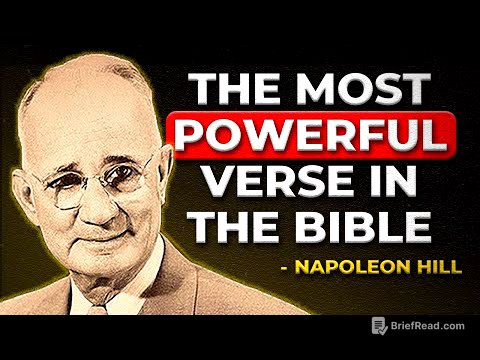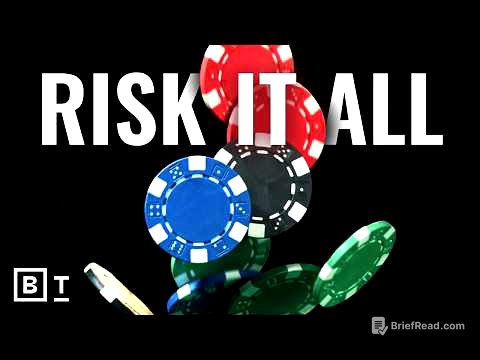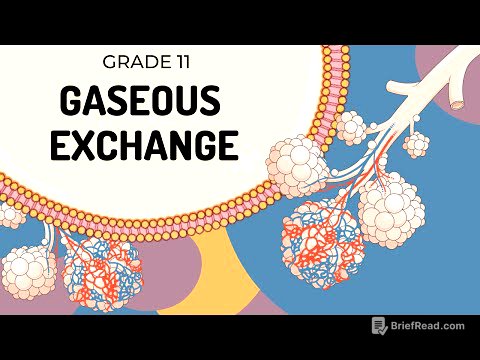TLDR;
This lecture introduces the concept of chemical equilibrium, defining it in terms of both concentration and reaction rates. It explores graphical representations of equilibrium, differentiates between reversible and irreversible reactions, and introduces the law of mass action. The lecture also covers equilibrium constants (Kp and Kc), their characteristics, and the relationship between them, concluding with a discussion of reaction quotients, degree of dissociation, relative density, the Le Chatelier principle, and characteristics of equilibrium.
- Equilibrium is defined by constant measurable properties or equal forward and backward reaction rates.
- Graphs illustrate equilibrium attainment based on concentration and reaction rates.
- The law of mass action relates reaction rate to reactant concentrations.
- Kp and Kc are equilibrium constants based on partial pressure and concentration, respectively.
- Le Chatelier's principle explains how systems at equilibrium respond to changes in conditions.
Introduction to Chemical Equilibrium [0:16]
The lecture begins with an introduction to chemical equilibrium, defining it using two key terms: concentration and rate. Equilibrium, in terms of reaction rate, is the state where the rate of the forward reaction equals the rate of the backward reaction. Alternatively, in terms of concentration, it's the state where measurable properties like temperature, pressure, density, and volume remain constant.
Defining Equilibrium: Concentration vs. Rate [0:30]
The lecture provides two definitions of equilibrium. The first, based on concentration, defines equilibrium as the state of a system where all measurable properties, such as temperature, pressure, volume, and density, are constant. The second definition, based on rate, states that equilibrium is achieved when the rate of the forward reaction equals the rate of the backward reaction.
Graphical Representation of Equilibrium: Concentration [4:00]
The lecture uses graphs to illustrate equilibrium in terms of concentration and reaction progress. The concentration of reactants decreases as they are consumed, while the concentration of products increases. Equilibrium is attained when the concentrations of both reactants and products become constant, represented by a horizontal line on the graph. Points on the graph are analysed to determine whether equilibrium has been attained by examining if the concentration is constant at that point.
Graphical Representation of Equilibrium: Rate [14:33]
Graphs are used to explain equilibrium with respect to rate and reaction progress. The rate of the forward reaction (reactants converting to products) and the rate of the backward reaction (products converting back to reactants) are examined. Equilibrium is achieved when these rates are equal, indicated by the point where the lines representing the forward and backward rates intersect on the graph.
Chemical Reactions: Reversible vs. Irreversible
The lecture distinguishes between irreversible and reversible chemical reactions. Irreversible reactions proceed to completion, with reactants being fully consumed and products unable to revert to reactants, represented by a single arrow in the reaction equation. Reversible reactions, on the other hand, never reach completion, with products capable of recombining to form reactants, indicated by a double arrow in the reaction equation. Equilibrium can only be attained in reversible reactions.
Law of Mass Action: Rate and Active Mass
The law of mass action states that the rate at which a substance reacts is directly proportional to its active mass. For a chemical reaction, the rate is proportional to the product of the active masses of the reacting substances. Active mass is represented by square brackets and has units of moles per litre. For solid substances, the active mass is considered unity.
Applying the Law of Mass Action
The lecture demonstrates how to apply the law of mass action to a reversible reaction (A + B ⇌ C + D). The rate of the forward reaction (v1) is proportional to the product of the active masses of reactants A and B, while the rate of the backward reaction (v2) is proportional to the product of the active masses of products C and D. At equilibrium, v1 = v2, leading to the derivation of the equilibrium constant (K equilibrium) in terms of active masses.
Equilibrium Constant: Kp and Kc
The equilibrium constant (K equilibrium) is further divided into Kp and Kc, representing equilibrium constants with respect to partial pressure and concentration, respectively. Kc is calculated using active masses of products divided by active masses of reactants, with stoichiometric coefficients as powers. Kp is calculated similarly, using partial pressures instead of concentrations, and is applicable only to gases.
Calculating Kc: Stoichiometric Coefficients
The lecture explains how to calculate Kc for reactions with stoichiometric coefficients of one and for general reactions where stoichiometric coefficients are not one. When stoichiometric coefficients are not one, they are used as powers for the respective concentrations in the Kc expression. The units and expression for Kc are also discussed, with examples provided.
Calculating Kp: Partial Pressures
Kp is applicable only for gases and is calculated using partial pressures. The lecture provides the formula for calculating partial pressure (moles of a component divided by total number of moles, multiplied by total pressure). It also explains how to write the Kp expression for a general reaction with different stoichiometric coefficients.
Relationship Between Kp and Kc
The lecture establishes the relationship between Kp and Kc, starting with the ideal gas equation (PV = nRT). For a reaction with stoichiometric coefficients of one, Kp is equivalent to Kc. For a general reaction with different stoichiometric coefficients, the relationship is expressed as Kp = Kc(RT)^Δng, where Δng is the change in the number of moles of gaseous products minus the number of moles of gaseous reactants.
Reaction Quotient and Equilibrium Constant
The reaction quotient (Q) is introduced as a measure of the relative amount of products and reactants present in a reaction at any given time. It is calculated in the same way as the equilibrium constant (K) but is not necessarily at equilibrium. Comparing Q with K allows predicting the direction a reversible reaction will shift to reach equilibrium: if Q = K, the reaction is at equilibrium; if Q > K, the reaction will proceed in the backward direction; if Q < K, the reaction will proceed in the forward direction.
Degree of Dissociation
The degree of dissociation (α) is defined as the fraction of reactant molecules that have dissociated at equilibrium. The lecture explains how to calculate α for a given reaction, relating it to the initial and equilibrium concentrations of reactants and products. The percentage dissociation is also discussed, and examples are provided to illustrate the calculations.
Relative Density and Degree of Dissociation
The relationship between relative density and degree of dissociation is explored. The lecture provides the formula for calculating the degree of dissociation (α) using theoretical and observed vapour densities, along with the number of moles dissociated.
Le Chatelier's Principle: Effect of Temperature
Le Chatelier's principle states that if a system at equilibrium is subjected to a change in conditions (concentration, temperature, or pressure), the equilibrium will shift in a direction that tends to relieve the stress. The effect of temperature is discussed, differentiating between exothermic (heat released) and endothermic (heat absorbed) reactions. Increasing temperature favours the backward reaction in exothermic reactions and the forward reaction in endothermic reactions, and vice versa.
Le Chatelier's Principle: Effect of Concentration
The effect of concentration on equilibrium is explained. Increasing the concentration of reactants shifts the equilibrium in the forward direction, while decreasing it shifts the equilibrium in the backward direction. Similarly, increasing the concentration of products shifts the equilibrium in the backward direction, and decreasing it shifts the equilibrium in the forward direction.
Le Chatelier's Principle: Effect of Pressure and Other Factors
The effect of pressure on equilibrium is discussed, noting that pressure is directly proportional to the number of moles. Increasing pressure favours the side with fewer moles of gas, while decreasing pressure favours the side with more moles of gas. The effects of a catalyst (no effect on equilibrium, only speeds up attainment) and the addition of inert gases are also mentioned.
Characteristics of Equilibrium
The lecture summarises the characteristics of equilibrium, including constant measurable properties, establishment from either side, the effect of catalysts, dynamic nature, and the response to external stresses as described by Le Chatelier's principle.
Question Time: Applying Equilibrium Concepts
The lecture concludes with example questions to apply the concepts learned. These include writing the relationship between Kp and Kc for given reactions, calculating the equilibrium constant for the formation of HI, determining which equilibrium is not shifted by an increase in pressure, and analysing how the rate of a reaction changes with changes in reactant concentrations.









